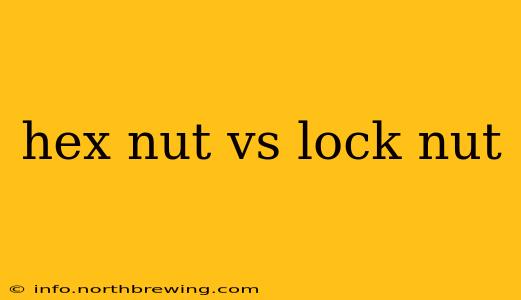Nuts and bolts are fundamental fasteners in countless applications, from simple household repairs to complex engineering projects. While both hex nuts and lock nuts serve to secure bolts, their core differences lie in their design and intended purpose. Understanding these distinctions is crucial for choosing the right fastener for the job, ensuring structural integrity and preventing unwanted loosening. This guide will explore the key differences between hex nuts and lock nuts, clarifying their functionalities and highlighting their specific applications.
What is a Hex Nut?
A hex nut, also known as a hexagonal nut, is the most common type of nut. Its defining characteristic is its six-sided (hexagonal) shape, which provides a good grip for wrenches. Hex nuts are simple, inexpensive, and readily available in various materials (steel, stainless steel, brass, nylon, etc.) and sizes. Their design allows for easy tightening and loosening using standard wrenches or sockets. The simplicity of the hex nut makes it suitable for a wide range of applications where a strong, reliable, and easily assembled connection is needed.
What is a Lock Nut?
A lock nut is a specialized nut designed to resist loosening under vibration or stress. Unlike standard hex nuts, lock nuts incorporate features that enhance their holding power, preventing them from vibrating loose over time. There are several types of lock nuts, each utilizing a different mechanism to achieve this:
Types of Lock Nuts:
-
Nylon Insert Lock Nuts: These nuts contain a nylon ring embedded within the nut. This nylon ring deforms slightly when tightened, creating friction against the bolt threads, preventing loosening. They are commonly used in applications where high vibration is not expected.
-
All-Metal Lock Nuts: These nuts utilize various designs to increase friction or create a locking mechanism, such as:
- Castle Nuts: These nuts have slots that allow a cotter pin to be inserted through a hole in the bolt, physically preventing the nut from turning.
- Jam Nuts: Two standard nuts are used in sequence, with the second nut acting as a jam nut to prevent the first from loosening.
- Prevailing Torque Nuts: These nuts employ a deformed or shaped section that creates friction against the bolt, resisting loosening. This deformation can be achieved through various techniques, such as a deformed section of the nut or a serrated internal design.
Hex Nut vs. Lock Nut: Key Differences Summarized
| Feature | Hex Nut | Lock Nut |
|---|---|---|
| Design | Simple hexagonal shape | Incorporates locking features |
| Function | Secure bolts | Secure bolts and resist loosening under stress |
| Vibration Resistance | Low | High |
| Cost | Low | Generally higher |
| Applications | General purpose fastening | Applications requiring high vibration resistance |
What are the applications of hex nuts?
Hex nuts are used in a vast array of applications where a strong and reliable connection is needed, such as:
- Automotive: Securing various components in vehicles.
- Construction: Fastening structural elements.
- Machinery: Assembling machine parts.
- Furniture: Connecting furniture components.
- General household repairs: Fixing and assembling various items.
What are the applications of lock nuts?
Lock nuts find their niche in applications where maintaining the secureness of the fastener is paramount despite vibrations or other stresses. Examples include:
- Automotive: Securing critical components that experience vibration, such as wheel studs.
- Aerospace: Applications requiring high reliability and safety under extreme conditions.
- Industrial machinery: Preventing loosening in high-vibration equipment.
- Construction (specialized): Securing components in areas prone to shaking or movement.
Which nut should I use?
The choice between a hex nut and a lock nut depends on the specific application. If the application involves minimal vibration or stress, a standard hex nut is often sufficient. However, for applications with significant vibration, shock, or other factors that could cause loosening, a lock nut is essential to ensure the safety and integrity of the assembly. Always consult engineering specifications and best practices for the particular application.
Are lock nuts more expensive than hex nuts?
Generally, yes. The added features incorporated into lock nuts increase their manufacturing cost, making them slightly more expensive than standard hex nuts. However, the increased cost is often justified by the improved reliability and safety they provide in critical applications.
This detailed comparison of hex nuts and lock nuts clarifies their distinctions and guides you in making informed decisions about fastener selection for your projects. Remember, choosing the right fastener is crucial for ensuring the safety and reliability of any assembly.
